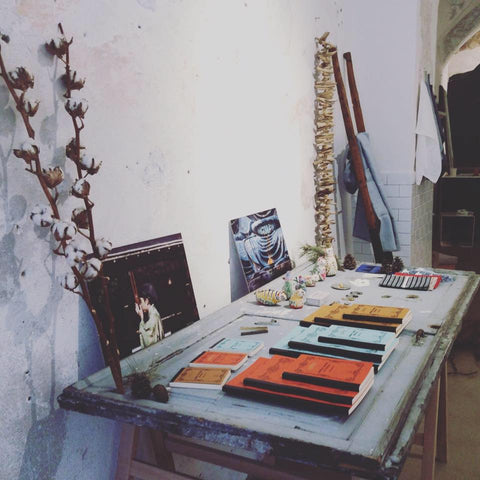
You never change things by fighting the existing reality. To change something, build a new model that makes the existing model obsolete
Richard Buckminster 'Bucky' Fuller
Fashion and design trend analysts generally assume that the broader societal context will not undergo a marked change and, as a consequence, is not a relevant variable.
By contrast, here at WazArs we hold that history matters and that it is on an accelerating trajectory (Iran tells India to pay for oil ‘only in euros’, PressTV, 29 December 2015; New type of moon rock discovered by Chinese lunar lander, Guardian, 22 December 2015; Antarctica: Tasmania could provide technical support for Chinese expeditions after new agreement signed, ABC, 10 September 2015; Hollywood on the Yellow Sea, the Atlantic, December 2015; Will China's growing box office dominance change Hollywood for ever?, Guardian, 10 September 2015; China’s middle class is going to have a big impact on luxury fashion, Quartz, 20 December 2015).
The East, by now largely self-sufficient, will not be dramatically affected by the failing Western banking system and will instead attract scores of European and North American creative and innovative minds.
In their time of trial, Western societies will react to the debacle by developing globally P2P networked, holacratic cooperatives and self-organizing collectives of digital nomads in a burst of socio-cultural, technological and economic creativity driven by necessity and by the Chinese Internet Plus project (Cyber Silk Road), with its emphasis on ecommerce, home delivery, mobile Internet, cloud computing, and the internet of things (China needs to develop e-commerce, industrial networks, and Internet banking: Ren, 17 july 2015).
These events and phenomena will obviously have huge long term effects, marking the beginning of a new evolutionary phase of human civilization centred on the principle that human design, just like natural design, evolves by shaping patterns that fosters greater energy efficiency, beauty, elegance and resilience, that is to say, systems in which energy flows unobstructed and entropy is exported out.
Another big socio-cultural trend of this century will be a backlash against digital addictions and wi-fi pollution and a more sensible relationship with smartphones and social media, accompanied by a widespread need for a return to nature.
Landscape architecture, interior and product design, digital craftsmanship will involve psychology and the social sciences, in order to refocus on context, respect and the dignity of human beings, on their true needs, questions and demands.
After all, undisciplined, short-sighted, forgetful, naive and inconsiderate creative forces may do far more harm than good. Unrestrained creative forces are insufficiently sympathetic to and generally divorced from actual human beings (A Plea for an Uncreative City. About Rotterdam). For them, diversity is an obstacle that must be overcome and human life is to be subjected to a standard of technical efficiency and aesthetic harmony.
They are prone to superimpose a fantastic, lifeless reality upon a tangible, animated one. They do not acknowledge their imperfections, as their chief goal is to keep alive their imagination and desires, their longing for coherence, order, unity, freshness, purity, clarity, dualism, vitality, strength of will, appropriateness and, above all, meaning, which mask the duplicity and the pettiness of some, the fatuity of others, the naive idealism of still others.
When considering all of the above, we side with those influencers who, for the period 2016-2017 and beyond, foresee themes, motifs, memes, archetypes, clues, intimations and moods broadly associated with the notions of:
movement, transformation, metamorphosis, mutation, change, emancipation, interconnectivity, cultural and disciplinary border-crossing, wonder, surprise, syncretism, integration, experimentalism, innovation, groundbreaking, fluidity and fluid geometry, openness, porousness, transcendence of space, time, routines and traditional classifications (more flexible identities), unity in diversity, reconciliation of opposites (west and east, vintage and contemporary, handmade/artisanal and industrial/mass produced, digital and analogic, natural and artificial), transition, ecology, biomimicry, upcycling (recycling, repurposing, reinventing and reusing) and resilience, contemplation of nature and oneself, bringing the outdoors in, nature-related greens, browns, and greys, as well as pastels (warm and calming hues), raw materials (marble, wood), plants to contrast sterile environments, glass, light, meditation, simplicity, serenity, silence, clean aesthetics, classic and minimal design, intuition, soft power, sovereignty, space and oceans, reinterpretation and revitalization of traditions (classicism too), deep experiences and wisdom, probabilistic instead of deterministic, viral and rhizomatic instead of linear/sequential, bottom up instead of top down, decentralization instead of centralization, multipolarism instead of unipolarism, multifunctionality, irony, irreverence, free-spiritedness and playfulness, people-centred design, customisation, made-to-order, peer-to-peer trading, divergent, lateral thinking, the world as a communion of subjects, “Peace through Culture”, “Beauty will save the World”, lifelong learning and diversification, detoxification, critical and ethical consumption.
Now that several garments are offered cheaper than a sandwich we all know and feel that something is profoundly and devastatingly wrong. But worst of all is the symbolism of it all. Prices profess that these clothes are to be thrown away, discarded as a condom and forgotten before being loved and savoured, teaching young consumers that fashion has no value. The culture of fashion is thus destroyed…The consumers of today and tomorrow are going to choose for themselves, creating and designing their own wardrobes. They will share clothes amongst each other since ownership doesn’t mean a thing anymore. They will rent clothes, lend clothes, transform clothes and find clothes on the streets.
Lidewij Edelkoort, Li Edelkoort publishes manifesto explaining why “fashion is obsolete”, Dezeen, 3 march 2015
